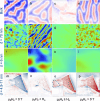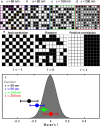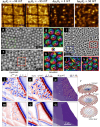Nanoscale Magnetic Effects in CrGeTe3-A Review
- PMID: 40589527
- PMCID: PMC12206184
- DOI: 10.1007/s10948-025-06987-8
Nanoscale Magnetic Effects in CrGeTe3-A Review
Abstract
Van der Waals (vdW) ferromagnets have garnered extensive attention thanks to their layered structures and the possibility of thinning them down to just a few atomic layers. This review discusses the emergent nanoscale magnetism in CrGeTe₃ (CGT), a 2-D vdW ferromagnet, focusing on its nanoscale properties and potential spintronic applications. We report on local magnetic probe techniques showing that thin CGT films exhibit spontaneous global magnetization at zero field, while thicker flakes display a hard ferromagnetic response only at their edges. We then focus on magnetic edge states in CGT thin films and their potential applications, where direct amorphization of CGT results in magnetic edges similar to those in cleaved films. By fabricating nanopatterned magnetic arrays, it has been demonstrated that tunable magnetic states emerge with anomalous coercivity. Moreover, we present the potential to realize artificial spin-ice configurations through antiferromagnetic dipolar coupling. The review delves into CGT heterostructures, which have demonstrated an anomalous Hall effect, expanding the scope of phenomena accessible in thin magnets. Finally, we discuss observation of magnetic bubbles and skyrmions, which offer additional opportunities for exploring chiral domain structures. The studies of CGT underscore the promise of fundamental investigations into 2-D magnetism while opening new pathways for spintronic applications based on nanoscale magnetic effects and frustration phenomena.
Keywords: CrGeTe3; Magnetic imaging; Magnetism; Skirmion; Van der Waals materials.
© The Author(s) 2025.
Conflict of interest statement
Conflict of interestThe authors declare no competing interests.
Figures










References
-
- Zhang, W., Wong, P.K.J., Zhu, R., van der Wee, A.T.S.: Waals magnets: wonder building blocks for two-dimensional spintronics? InfoMat 1, 479–495 (2019)
-
- Jin, C., Kou, L.: Two-dimensional non-van der Waals magnetic layers: functional materials for potential device applications. J. Phys. D Appl. Phys. 54, 413001 (2021)
-
- Deng, Y., et al.: Layer–number-dependent magnetism and anomalous Hall effect in van der Waals ferromagnet Fe 5 GeTe 2. Nano Lett. 22, 9839–9846 (2022) - PubMed
-
- Thiel, L., et al.: Probing magnetism in 2D materials at the nanoscale with single-spin microscopy. Science 1979(364), 973–976 (2019) - PubMed
Publication types
LinkOut - more resources
Full Text Sources
